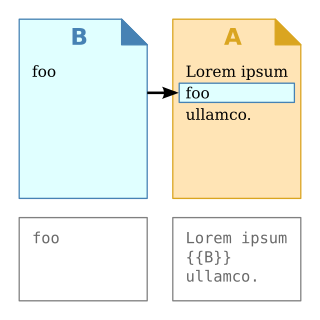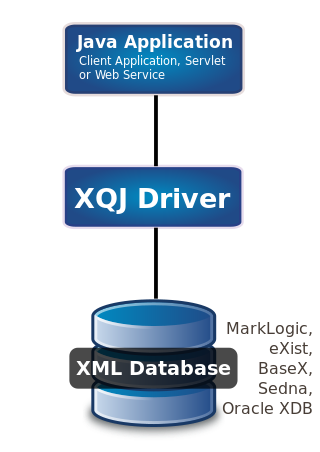
In computer science, transclusion is the inclusion of part or all of an electronic document into one or more other documents by reference via hypertext. Transclusion is usually performed when the referencing document is displayed, and is normally automatic and transparent to the end user. The result of transclusion is a single integrated document made of parts assembled dynamically from separate sources, possibly stored on different computers in disparate places.

An object database or object-oriented database is a database management system in which information is represented in the form of objects as used in object-oriented programming. Object databases are different from relational databases which are table-oriented. A third type, object–relational databases, is a hybrid of both approaches. Object databases have been considered since the early 1980s.

A programming language is a system of notation for writing computer programs.

Extensible Markup Language (XML) is a markup language and file format for storing, transmitting, and reconstructing arbitrary data. It defines a set of rules for encoding documents in a format that is both human-readable and machine-readable. The World Wide Web Consortium's XML 1.0 Specification of 1998 and several other related specifications—all of them free open standards—define XML.
XSLT is a language originally designed for transforming XML documents into other XML documents, or other formats such as HTML for web pages, plain text or XSL Formatting Objects, which may subsequently be converted to other formats, such as PDF, PostScript and PNG. Support for JSON and plain-text transformation was added in later updates to the XSLT 1.0 specification.
Mathematical Markup Language (MathML) is a mathematical markup language, an application of XML for describing mathematical notations and capturing both its structure and content, and is one of a number of mathematical markup languages. Its aim is to natively integrate mathematical formulae into World Wide Web pages and other documents. It is part of HTML5 and standardised by ISO/IEC since 2015.
James Clark is a software engineer and creator of various open-source software including groff, expat and several XML specifications.
Saxon is an XSLT and XQuery processor created by Michael Kay and now developed and maintained by his company, Saxonica. There are open-source and also closed-source commercial versions. Versions exist for Java, JavaScript and .NET.

The Oxygen XML Editor is a multi-platform XML editor, XSLT/XQuery debugger and profiler with Unicode support. It is a Java application so it can run in Windows, Mac OS X, and Linux. It also has a version that can run as an Eclipse plugin.
The Semantic Web Rule Language (SWRL) is a proposed language for the Semantic Web that can be used to express rules as well as logic, combining OWL DL or OWL Lite with a subset of the Rule Markup Language.

Donald D. Chamberlin is an American computer scientist who is one of the principal designers of the original SQL language specification with Raymond Boyce. He also made significant contributions to the development of XQuery.
Scribe is a markup language and word processing system that pioneered the use of descriptive markup. Scribe was revolutionary when it was proposed, because it involved for the first time a clean separation of presentation and content.
XML retrieval, or XML information retrieval, is the content-based retrieval of documents structured with XML. As such it is used for computing relevance of XML documents.
XQuery is a query and functional programming language that queries and transforms collections of structured and unstructured data, usually in the form of XML, text and with vendor-specific extensions for other data formats. The language is developed by the XML Query working group of the W3C. The work is closely coordinated with the development of XSLT by the XSL Working Group; the two groups share responsibility for XPath, which is a subset of XQuery.

XQuery API for Java (XQJ) refers to the common Java API for the W3C XQuery 1.0 specification.

An XML transformation language is a programming language designed specifically to transform an input XML document into an output document which satisfies some specific goal.
In computer software testing, a test assertion is an expression which encapsulates some testable logic specified about a target under test. The expression is formally presented as an assertion, along with some form of identifier, to help testers and engineers ensure that tests of the target relate properly and clearly to the corresponding specified statements about the target. Usually the logic for each test assertion is limited to one single aspect specified. A test assertion may include prerequisites which must be true for the test assertion to be valid.
srcML is a document-oriented XML representation of source code. It was created in a collaborative effort between Michael L. Collard and Jonathan I. Maletic. The abbreviation, srcML, is short for Source Markup Language. srcML wraps source code (text) with information from the Abstract Syntax Tree or AST (tags) into a single XML document. All original text is preserved so that the original source code document can be recreated from the srcML markup. The only exception is the possibility of newline normalization.

Jenifer Fays Alys Tennison is a British software engineer and consultant who co-chairs the data governance working group within the Global Partnership on Artificial Intelligence (GPAI). She also serves on the board of directors of Creative Commons, the Global Partnership for Sustainable Development Data (GPSDD) and the information law and policy centre of the School of Advanced Study (SAS) at the University of London. She was previously Chief Executive Officer (CEO) of the Open Data Institute (ODI).
In markup languages and the digital humanities, overlap occurs when a document has two or more structures that interact in a non-hierarchical manner. A document with overlapping markup cannot be represented as a tree. This is also known as concurrent markup. Overlap happens, for instance, in poetry, where there may be a metrical structure of feet and lines; a linguistic structure of sentences and quotations; and a physical structure of volumes and pages and editorial annotations.









